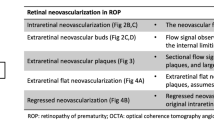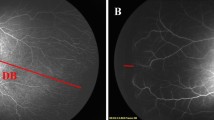Abstract
Objective
Evaluation of optical coherence tomography biomarkers in predicting treatment response to intravitreal injection of anti-vascular endothelial growth factor (anti-VEGF) Bevacizumab, in aggressive retinopathy of prematurity (A-ROP).
Methods
Non-contact ultra-widefield (NC-UWF) fundus imaging with integrated UWF guided swept source Optical coherence tomography (SS-OCT) was performed prospectively in preterm babies before and after intravitreal anti-VEGF (Bevacizumab) monotherapy. OCT biomarkers were analysed in eyes that reached complete vascularization versus others.
Results
Eyes with retinal vessels reaching near ora serrata were labelled as regressed ROP and vascularised retina (Group1). Eyes with reactivation of ROP needing laser or vitreoretinal surgery or eyes with peripheral avascular retina (PAR) at 16th week post-injection were considered as Group 2. Pre-injection baseline OCT showed a hyperreflectivity of inner retinal layers in 12 out of 46 eyes in Group 1 versus 30 out of 34 eyes in Group 2 (p value 0.002). None of the eyes in Group 1 showed choroidal thinning at posterior pole as compared to 14 out of 34 eyes in Group 2 (p value 0.001). Intraretinal hypo reflective Cystic changes at fovea were seen in 16 out of 46 eyes in Group 1 and 2 out of 34 eyes in Group 2 (p value 0.012).
Conclusion
Pre-injection swept source OCT biomarkers could predict the treatment outcomes of anti-VEGF (Bevacizumab) monotherapy in A-ROP eyes. Hyperreflectivity of inner retinal layers and choroidal thinning had poorer and unpredictable response to anti-VEGF injection whereas, cystic changes at fovea predicted favourable response.
This is a preview of subscription content, access via your institution
Access options
Subscribe to this journal
Receive 18 print issues and online access
$259.00 per year
only $14.39 per issue
Buy this article
- Purchase on Springer Link
- Instant access to full article PDF
Prices may be subject to local taxes which are calculated during checkout





Similar content being viewed by others
Data availability
Data set is available with author Akash Belenje and at ROP database office at LV Prasad Eye Institute, Hyderabad, Telangana, India-500034.
References
Chiang MF, Quinn GE, Fielder AR, Ostmo SR, Paul Chan RV, Berrocal A, et al. International classification of retinopathy of prematurity, third edition. Ophthalmology. 2021;128:e51–68. https://doi.org/10.1016/j.ophtha.2021.05.031.
Bellsmith KN, Brown J, Kim SJ, Goldstein IH, Coyner A, Ostmo S, et al. Aggressive posterior retinopathy of prematurity: clinical and quantitative imaging features in a large North American Cohort. Ophthalmology. 2020;127:1105–12. https://doi.org/10.1016/j.ophtha.2020.01.052.
Jalali S, Kesarwani S, Hussain A. Outcomes of a protocol-based management for zone 1 retinopathy of prematurity: the Indian Twin Cities ROP Screening Program report number 2. Am J Ophthalmol. 2011;151:719–24.e2. https://doi.org/10.1016/j.ajo.2010.10.007.
Good WV. Final results of the early treatment for retinopathy of prematurity (ETROP) randomized trial. Trans Am Ophthalmol Soc. 2004;102:233–48.
Beccasio A, Mignini C, Caricato A, Iaccheri B, Di Cara G, Verrotti A, et al. New trends in intravitreal anti-VEGF therapy for ROP. Eur J Ophthalmol. 2022;32:1340–51. https://doi.org/10.1177/11206721211073405.
Wang SD, Zhang GM, Shenzhen Screening for Retinopathy of Prematurity Cooperative Group. Laser therapy versus intravitreal injection of anti-VEGF agents in monotherapy of ROP: a meta-analysis. Int J Ophthalmol. 2020;13:806–15. https://doi.org/10.18240/ijo.2020.05.17.
Mintz-Hittner HA, Kennedy KA, Chuang AZ, BEAT-ROP Cooperative Group. Efficacy of intravitreal bevacizumab for stage 3+ retinopathy of prematurity. N. Engl J Med. 2011;364:603–15. https://doi.org/10.1056/NEJMoa1007374.
Autrata R, Senková K, Holousová M, Krejcírová I, Dolezel Z, Borek I. Prínos intravitreální aplikace anti-VEGF preparátů v lécbe prahového stadia ROP 3+ v zóne I–II: výsledky ctyrleté studie [Effects of intravitreal pegaptanib or bevacizumab and laser in treatment of threshold retinopathy of prematurity in zone I and posterior zone II-four years results]. Cesk Slov Oftalmol. 2012;68:29–36.
Sankar MJ, Sankar J, Chandra P. Anti-vascular endothelial growth factor (VEGF) drugs for treatment of retinopathy of prematurity. Cochrane Database Syst Rev. 2018;1:CD009734. https://doi.org/10.1002/14651858.CD009734.pub3.
Belenje, A, Reddy, RU, Optom, B, Agarwal K, Parmeswarappa DC, Jalali S. Non-contact widefield neonatal retinal imaging for retinopathy of prematurity using the Clarus 700 high resolution true colour reflectance imaging. Eye. 2022. https://doi.org/10.1038/s41433-022-02273-2.
Nguyen TP, Ni S, Khan S, Wei X, Ostmo S, Chiang MF, et al. Advantages of widefield optical coherence tomography in the diagnosis of retinopathy of prematurity. Front Pediatr. 2022;9:797684. https://doi.org/10.3389/fped.2021.797684.
Maldonado RS, Toth CA. Optical coherence tomography in retinopathy of prematurity: looking beyond the vessels. Clin Perinatol. 2013;40:271–96. https://doi.org/10.1016/j.clp.2013.02.007.
Hans A, Narang S, Sindhu M, Jain S, Chawla D. Fundus fluorescein angiography in retinopathy of prematurity. Eye (Lond). 2022;36:1604–9. https://doi.org/10.1038/s41433-021-01694-9.
Tan W, Li B, Wang Z, Zou J, Jia Y, Yoshida S, et al. Novel potential biomarkers for retinopathy of prematurity. Front Med (Lausanne). 2022;9:840030. https://doi.org/10.3389/fmed.2022.840030.
Vinekar A, Nair AP, Sinha S, Vaidya T, Chakrabarty K, Shetty R, et al. Tear fluid angiogenic factors: potential noninvasive biomarkers for retinopathy of prematurity screening in preterm infants. Invest Ophthalmol Vis Sci. 2021;62:2. https://doi.org/10.1167/iovs.62.3.2.
Sehgal P, Narang S, Chawla D, Gupta S, Jain S, Sharma U, et al. Systemic biomarkers of retinopathy of prematurity in preterm babies. Int Ophthalmol. 2022. https://doi.org/10.1007/s10792-022-02576-z.
Padhi TR, Bhusal U, Padhy SK, Patel A, Kelgaonker A, Khalsa A, et al. The retinal vascular growth rate in babies with retinopathy of prematurity could indicate treatment need. Indian J Ophthalmol. 2022;70:1270–7.
Agarwal K, Jalali S. Classification of retinopathy of prematurity: from then till now. Community Eye Health. 2018;31:S4–7.
Jalali S, Balakrishnan D, Zeynalova Z, Padhi TR, Rani PK. Serious adverse events and visual outcomes of rescue therapy using adjunct bevacizumab to laser and surgery for retinopathy of prematurity. The Indian Twin Cities Retinopathy of Prematurity Screening database Report number 5. Arch Dis Child Fetal Neonatal Ed. 2013;98:F327–33. https://doi.org/10.1136/archdischild-2012-302365.
Iwahashi C, Utamura S, Kuniyoshi K, Sugioka K, Konishi Y, Wada N, et al. Factors associated with reactivation after intravitreal bevacizumab or ranibizumab therapy in infants with retinopathy of prematurity. Retina. 2021;41:2261–8.
Hu J, Blair MP, Shapiro MJ, Lichtenstein SJ, Galasso JM, Kapur R. Reactivation of retinopathy of prematurity after bevacizumab injection. Arch Ophthalmol. 2012;130:1000–6.
Mintz-Hittner HA, Geloneck MM, Chuang AZ. Clinical management of recurrent retinopathy of prematurity after intravitreal bevacizumab monotherapy. Ophthalmology. 2016;123:1845–55.
Wood EH, Rao P, Moysidis SN, Dedania VS, Elman MJ, Drenser KA, et al. Fellow Eye anti-VEGF ‘Crunch’ effect in retinopathy of prematurity. Ophthalmic Surg Lasers Imaging Retin. 2018;49:e102–4. https://doi.org/10.3928/23258160-20180907-16.
Maldonado RS, O’Connell R, Ascher SB, Sarin N, Freedman SF, Wallace DK, et al. Spectral-domain optical coherence tomographic assessment of severity of cystoid macular edema in retinopathy of prematurity. Arch Ophthalmol. 2012;130:569–78. https://doi.org/10.1001/archopthalmol.2011.1846.
Chen X, Mangalesh S, Dandridge A, Tran-Viet D, Wallace DK, Freedman SF, et al. Spectral-Domain OCT findings of retinal vascular-avascular junction in infants with retinopathy of prematurity. Ophthalmol Retin. 2018;2:963–71. https://doi.org/10.1016/j.oret.2018.02.001.
Furashova O, Matthè E. Hyperreflectivity of inner retinal layers as a quantitative parameter of ischemic damage in acute retinal vein occlusion (RVO): an optical coherence tomography study. Clin Ophthalmol. 2020;14:2453–62. https://doi.org/10.2147/OPTH.S260000.
Huang YT, Chang YC, Meng PP, Lin CJ, Lai CT, Hsia NY, et al. Optical coherence tomography biomarkers in predicting treatment outcomes of diabetic macular edema after dexamethasone implants. Front Med (Lausanne). 2022;9:852022. https://doi.org/10.3389/fmed.2022.852022.
Wenzel DA, Poli S, Casagrande M, Druchkiv V, Spitzer MS, Bartz-Schmidt KU, et al. Inner retinal layer hyperreflectivity is an early biomarker for acute central retinal artery occlusion. Front Med (Lausanne). 2022;9:854288. https://doi.org/10.3389/fmed.2022.854288.
Wu W, Shih C, Wang N, Lien R, Chen YP, Chao AN, et al. Choroidal thickness in patients with a History of retinopathy of prematurity. JAMA Ophthalmol. 2013;131:1451–8. https://doi.org/10.1001/jamaophthalmol.2013.5052.
Erol MK, Coban DT, Ozdemir O, Dogan B, Tunay ZO, Bulut M. Choroidal thickness in infants with retinopathy of prematurity. Retina. 2016;36:1191–8. https://doi.org/10.1097/IAE.0000000000000866.
Pheng E, Lim ZD, Tai Li Min E, Rostenberghe HV, Shatriah I. Haemoglobin levels in early life among infants with and without retinopathy of prematurity. Int J Environ Res Public Health. 2021;18:7054. https://doi.org/10.3390/ijerph18137054.
Stutchfield C, Jain A, Odd D, Williams C, Markham R. Foetal haemoglobin, blood transfusion, and retinopathy of prematurity in very preterm infants: a pilot prospective cohort study. Eye. 2017;31:1451–5. https://doi.org/10.1038/eye.2017.76.
Funding
Hyderabad Eye Research Foundation (2020), Hyderabad, India The institute has received funding or support for its ongoing Retinopathy of Prematurity programs from Miriam Hyman Memorial Trust (MHMT, UK), Dalmia Holdings (India), Queen Elizabeth Diamond Jubilee Trust (UK), Public Health Foundation of India, Cognizant Foundation and the Government of India.
Author information
Authors and Affiliations
Contributions
AB and SJ: devised and designed the study, devised data collection protocol and data analysis, Literature search, wrote the Manuscript. DCP and TRP: helped in improving content and editing the manuscript. RUR and BS: captured the fundus and OCT images on Optos silverstone.
Corresponding author
Ethics declarations
Competing interests
The authors declare no competing interests.
Ethics approval
IRB approved with ethics number LEC-BHR-P-09-22-926.
Informed consent
Has been obtained from the person shown in Fig. 1 to use their image in published media.
Additional information
Publisher’s note Springer Nature remains neutral with regard to jurisdictional claims in published maps and institutional affiliations.
Supplementary information
Rights and permissions
Springer Nature or its licensor (e.g. a society or other partner) holds exclusive rights to this article under a publishing agreement with the author(s) or other rightsholder(s); author self-archiving of the accepted manuscript version of this article is solely governed by the terms of such publishing agreement and applicable law.
About this article
Cite this article
Belenje, A., Reddy, R.U., Parmeswarappa, D.C. et al. Evaluation of optical coherence tomography biomarkers to differentiate favourable and unfavourable responders to intravitreal anti-vascular endothelial growth factor treatment in retinopathy of prematurity. Eye 38, 1097–1103 (2024). https://doi.org/10.1038/s41433-023-02824-1
Received:
Revised:
Accepted:
Published:
Issue Date:
DOI: https://doi.org/10.1038/s41433-023-02824-1



